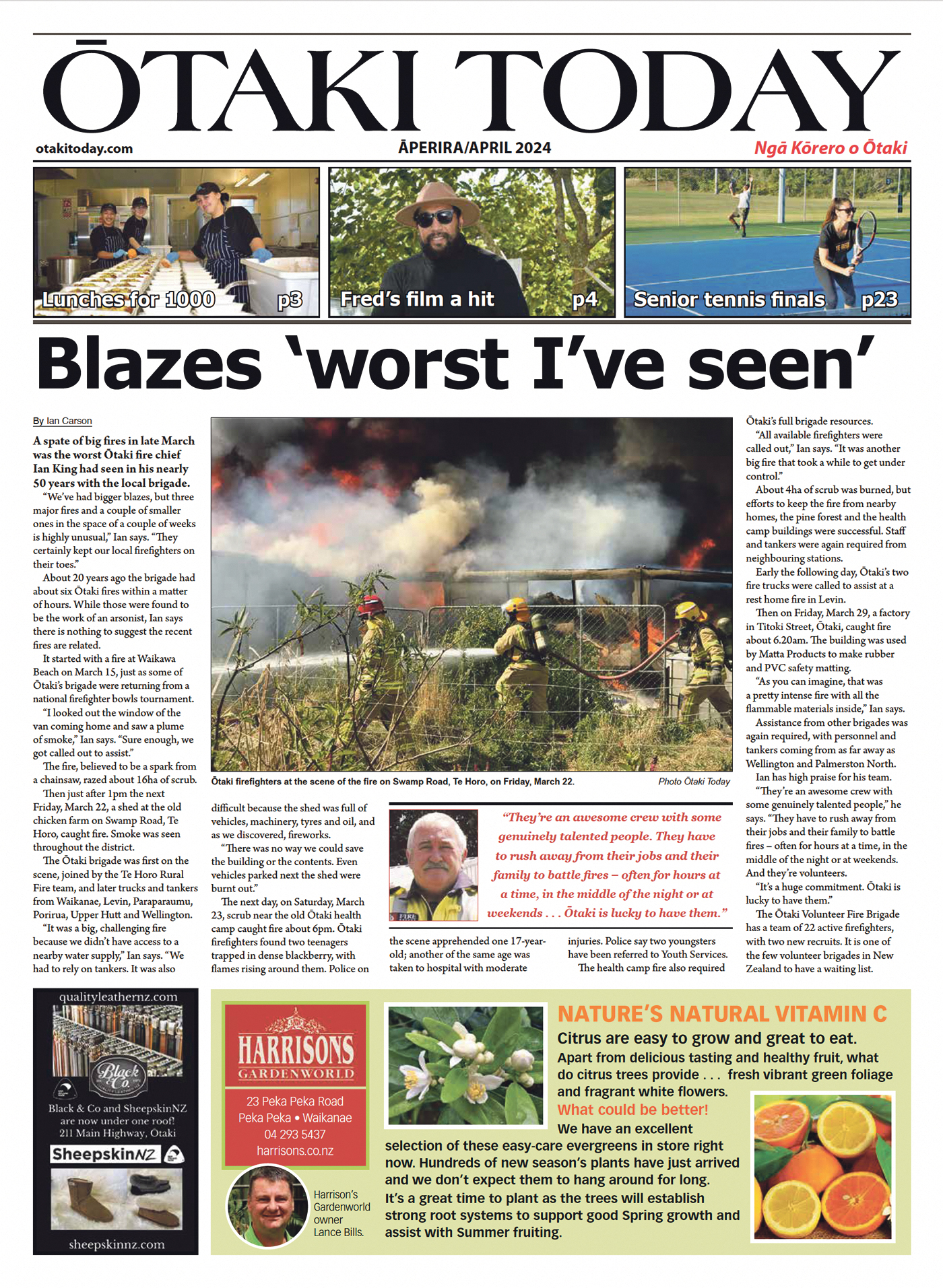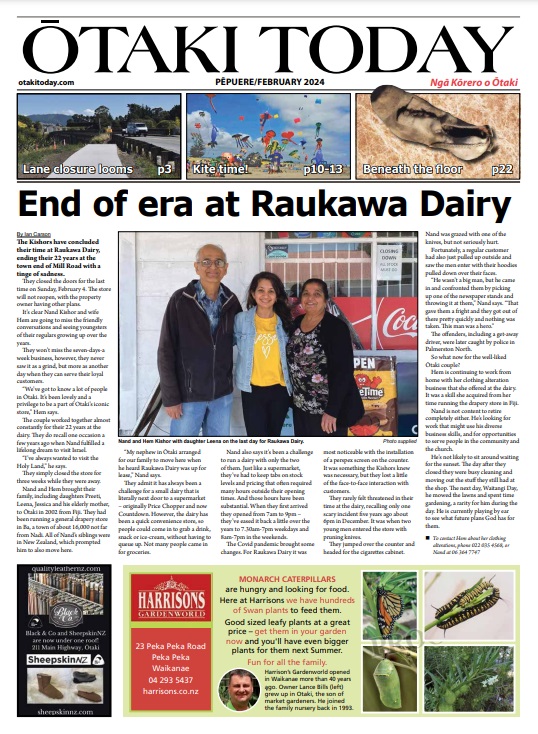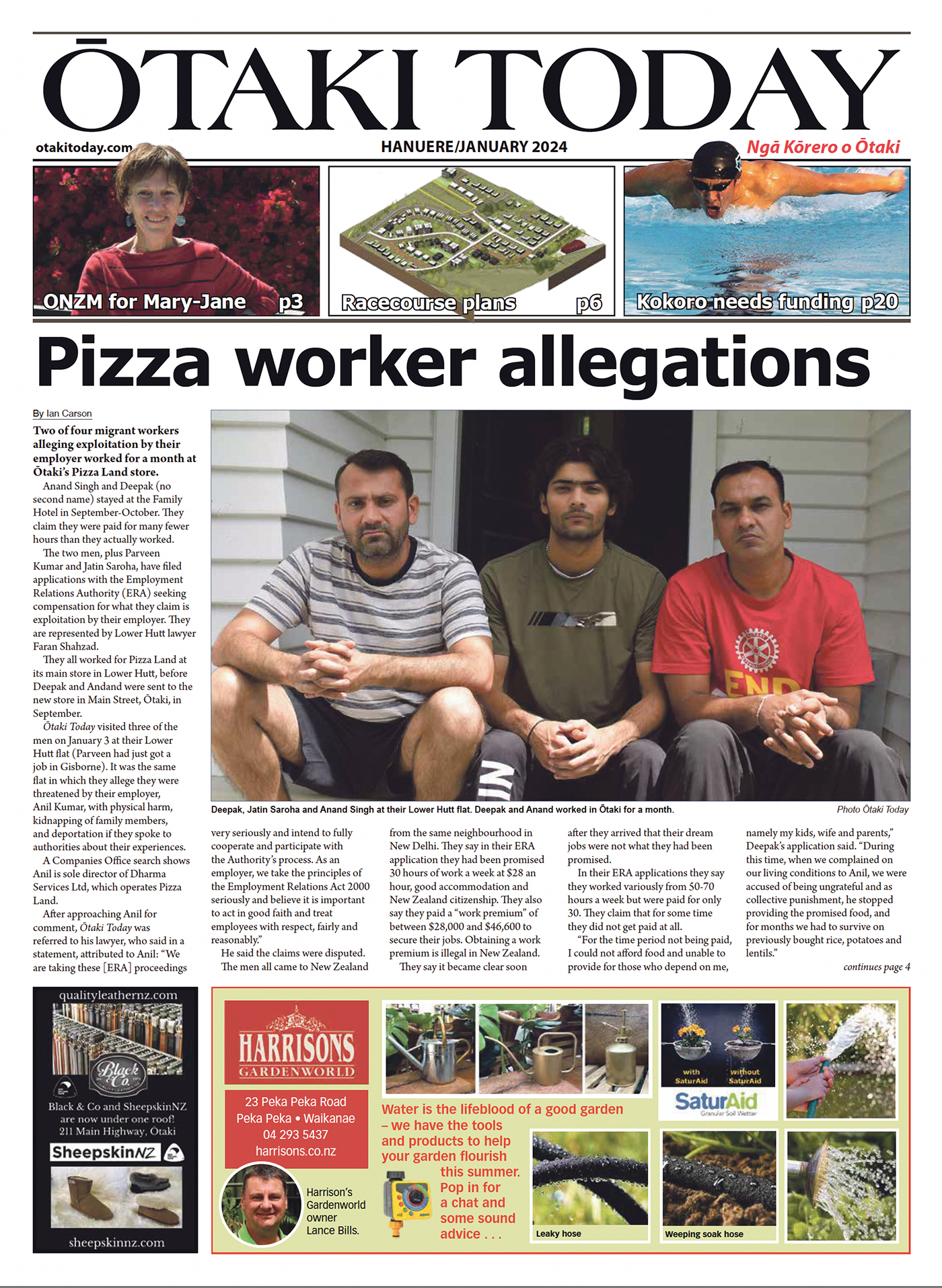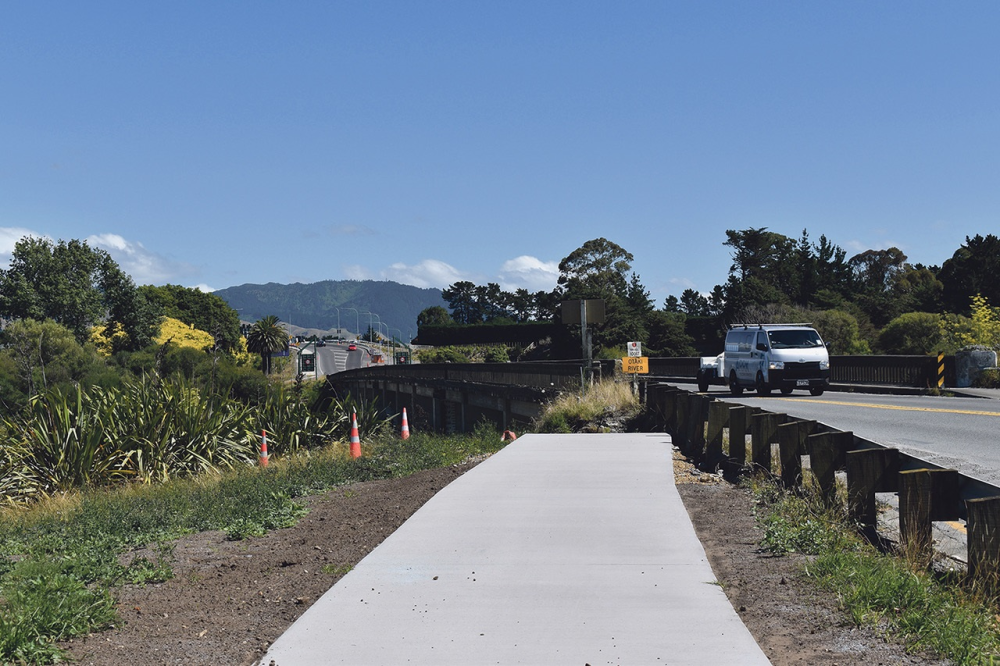
Transport agency Waka Kotahi has confirmed traffic on the old Ōtaki River bridge will be reduced to one lane beginning late May – and continuing until December.
Ōtaki Today reported last year that the bridge was to close in July 2023 for installation of a “clip-on” shared pathway. However, community backlash about a closure that would impede December holiday traffic led the agency to defer to this year. It told Ōtaki Today recently that work would have started before May this year, but with the Ōtaki Kite Festival this coming weekend, and other popular local community events in the coming months, it had deferred the installation date again.
“We are planning for the lane closure to begin in late May 2024 and continue until December 2024,” says Waka Kotahi infrastructure delivery regional manager Jetesh Bhula. “We are working with the project contractor to look at ways of reducing the time required for the lane closure.”
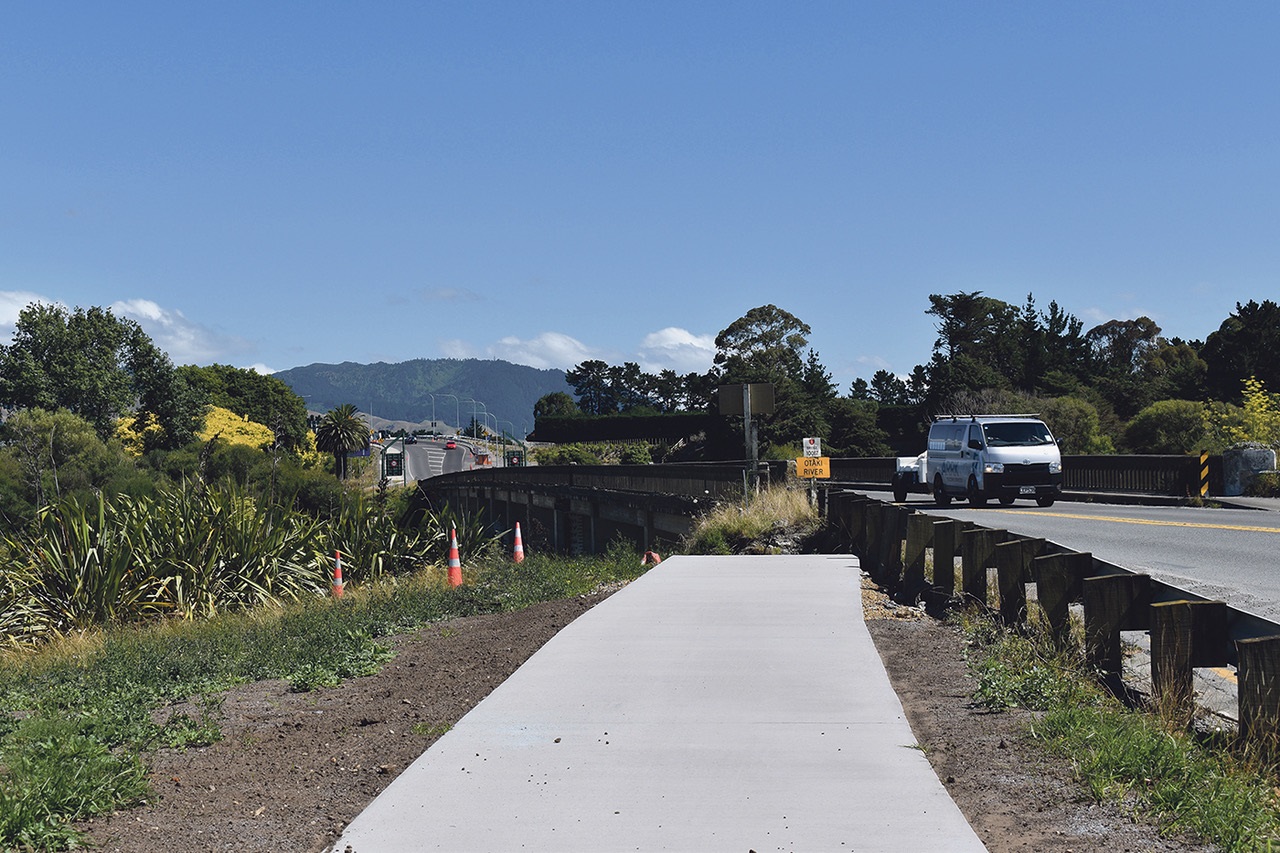
The old Ōtaki River bridge, with a new path waiting to connect to the “clip-on”.
Photo Ōtaki Today
While construction is under way, stop/go traffic signals will be used to control the long-term single-lane closure on the bridge. Signal phasing will be set to account for expected peak traffic flows, with priority given to peak flow directions. Traffic will be monitored, and, if required, phasing will be changed to ensure traffic delays are kept as short as possible.
The project will work with the Waka Kotahi Wellington Traffic Operations Centre (WTOC) to monitor and manage priority access for emergency services as required.
“We appreciate pedestrians and cyclists will want access over the river, and we are working with the contractor to provide pedestrian and cyclist access across the river during construction,” Jitesh says. “We do expect this
work to affect traffic flows and create congestion.
However, since the opening of the PP2Ō expressway, traffic volumes on old State Highway 1 have fallen by almost 60 percent.”
About 7900 vehicles now use it daily, compared to the more than 19,000 before PP2Ō opened. The lower traffic volumes and having an alternative route via PP2Ō is expected to mitigate a significant amount of the project’s impact.
A similar lane closure currently operating on the Waikanae River bridge has brought anger from motorists and local residents, and drawn a roadside protest supported by Ōtaki MP Tim Costley.
So why does it take so long to “clip on” a shared pathway?
Waka Kotahi says the works for both the Waikanae and Ōtaki bridges are significant, requiring substantial planning, design and construction.
While the term clip-on sounds simple and straightforward, the agency says the work involved is far more sophisticated and detailed.
At Ōtaki, the clip-on will be a 2.5-metre-wide shared path that will be installed on the upstream (eastern) side of the old Ōtaki River Bridge. This is an element of the completion works (revocation) for the Peka Peka to Ōtaki (PP2Ō) expressway project.
Project crews will install a steel substructure on each of the 14 bridge piers to support the new clip-on pathways. This requires scaffolding under the bridges to provide a platform for work crews.
In the case of Ōtaki, the scaffolding can’t sit in the riverbed because of flood risk. A substantial rainfall could wash away scaffolding; it has to hang from the bridge deck. To do this, the scaffolding must be anchored to the lane from the top of the bridge. That means an entire bridge lane must be closed 24 hours a day until the new shared pathway is installed.
“We appreciate a full lane closure does have a significant impact on traffic and does cause congestion and delays,” Jetesh Bhula says. “However, the nature of the work involved and the necessity to anchor the scaffolding to the bridge means no other viable options are available.”
The project has been worked on with the Kāpiti Coast District Council, community and various stakeholder groups. The latter includes the PP2Ō Community Liaison Group, Ngā Hapū o Ōtaki and Friends of the Ōtaki River.
The project will ensure walkers, cyclists and locals using old SH1 have a safe way to cross the bridge. The current downriver side of the bridge has had a narrow footpath for years, but it has no barriers against traffic.
“Separating walking and cycling paths from the road is the best and safest option as it removes any chance of pedestrians and cyclists being at risk from live traffic lanes,” Jetesh says.
The agency says it continues to discuss the project and its impact on traffic flows with the council. More information is expected to be sent out to residents, businesses and community groups as plans are developed further.
However, Waka Kotahi advises residents, businesses and road users to plan for the project and its impact. It anticipates congestion and delays to be worst when the project starts, but will reduce as people become used to the work and adapt to the lane closure.
• More details about the project can be found on the NZTA/Waka Kotahi website. Search for “Ōtaki River shared path” at nzta.govt.nz
OTHER STORIES
LATEST POSTS
- Councillor moots Blue Bluff swing bridge solution
- Local school lunches feed 1000 - Ōtaki Today
- Driver nabbed on expressway with kids at 175km-h
- Blazes worst I’ve seen – fire chief
- Cobblers Soup team looking for helpers
- Community gets behind Te Horo Hall fund
- Library recycling old domestic batteries recycling old domestic batteries
- Behind-scenes manoeuvres snag business association setup
- Reservoir work progresses apace
- Murals brighten Te Horo Beach toilets
- Local SAR teams help in bush search
- New passion, new business for busy Bee
- Kite crazy
- Green waste beach dumping concerns
- Six-month bridge lane closure looms
- End of an era as Raukawa Dairy closes
- Community at heart of Mary-Jane’s ONZM
- Cops nail burnout hoons
- Racing club development goes for consent
- Pizza workers claim exploitation
- Memories revived as teen friends reunite
- All Saints gets a spruce-up
- Kāinga Ora reveals new homes
- Jo enthusiastic about Ōtaki potential
- Challenges, but optimism for Ōtaki shops.
- Challenges, but optimism for Ōtaki shops
- New MP Tim ‘getting on with it’
- New first response unit for Ōtaki
- Bridge work brings stop-start traffic
- Te Horo keeps pushing for buses to the beach
- Trucker gate - Bulls hit road as door opens
- New heritage entity launched
- Brent honoured for 60 years in Scouts
- Report disputes Moy access safety issues
- Bryan helps Canadians with huge blazes
- New barrier saves driver
- Support for Te Horo bus stops
- Training begins at old health camp
- ‘Quiet’ streets threatened by development
- Don’s book adds to colourful garden history
- Reservoir residents’ hopes dashed
- Derek ‘excited’ about arcade plans
- Waitohu group helps hold back the sea
- Houses will have to move from coasts, says panel
- No-bus Te Horo riles locals
- Paula’s gift – knitting for babies and the elderly
- Months of traffic delays as bridge gets ‘clip-on
- Flax flattened at estuary
- King gives gongs for community work
- Council proposes relocating reservoir

